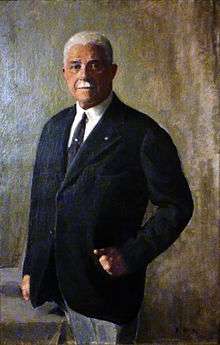Maximilian Egon II, Prince of Fürstenberg
| Maximilian Egon II, Prince of Fürstenberg | |
|---|---|
 Portrait of Maximilian Fürstenberg from the historic market hall of Freiburg |
Maximilian Egon II, Prince of Fürstenberg (1863-1941) was a substantial landowner and investor in Germany and also a member of the nobility in several German-speaking states, including Austria.
Family
Born as Maximilian Egon Christian Karl Aloys Emil Leo Richard Anton, Prince of Fürstenberg, he was the son of Maximilian Egon, Prince of Fürstenberg, and his wife Leontina, Countess of Khevenhüller-Metsch. He had a younger brother, born in 1867, Karl Emil Egon, Prince of Fürstenberg.
By his marriage to Countess Irma von Schönborn-Buchheim, Maximilian of Fürstenberg had three sons and two daughters:
- Karl Egon V zu Fürstenberg (1891–1973)
- Leontina zu Fürstenberg (1892–1979)
- Anna zu Fürstenberg (1894–1928)
- Maximilian Egon zu Fürstenberg (1896–1959)
- Friedrich Eduard zu Fürstenberg (1898–1916)
He also had an illegitimate daughter, Marie-Louise-Auguste von Almey, by a liaison with Freiin Marguerite von Almey.
Life
A close friend and adviser of the Emperor Wilhelm II of Germany,[1] Max of Fürstenberg inherited territorial titles in Prussia, Austria, Hungary, Württemberg and Baden, and by virtue of them had a seat in the House of Lords in each of the five states. Until the First World War he was vice-president of the Prussian House of Lords. His principal residence was at Donaueschingen, near the source of the Danube, where he owned a castle and great deer forests. The Emperor Wilhelm frequently visited him there, and Max invariably accompanied the Emperor on his hunting expeditions and Norwegian trips. As well as his vast ancestral forests, he also owned coal mines, hotels and breweries.[2]
Although he was a member of the high Roman Catholic Uradel who had long stood aloof from party politics, after meeting Hitler and Ernst Roehm in November 1933 Max became enthusiastic about Hitler's leadership, commenting "It was wonderful, to be able to meet such a great man".[1]
The same year, 1933, he joined the Nazi Party and the SA and in 1938 was appointed to the rank of Standartenführer. He died in 1941, during the Second World War, to be succeeded by his son Karl Egon (born 1891).[3]
Notes
References
 This article incorporates text from a publication now in the public domain: Rines, George Edwin, ed. (1920). "Fürstenberg, Maximilian Egon zu". Encyclopedia Americana.
This article incorporates text from a publication now in the public domain: Rines, George Edwin, ed. (1920). "Fürstenberg, Maximilian Egon zu". Encyclopedia Americana.
| Wikimedia Commons has media related to Max Egon II. zu Fürstenberg. |
